In a hurry? Then go directly to Our Recommendations.
Did you start playing floorball a while ago and want to buy your first stick but are you unsure due to all the choices? Or did you already buy your first stick but are unhappy with it? Perhaps you want to buy a stick for someone and are not sure where to start?
After reading this guide you will know how to choose a floorball stick so you can make a well-informed decision and buy your floorball stick with confidence.
You may be overwhelmed by the wide variety of sticks that currently occupy the market. Perhaps you heard well-intended advice from your floorball playing friends saying you should stick to Brand X or that Blade Y is a perfect fit. How well-intended the advice may be, it just adds to the confusion and you feel like picking your first stick is basically like buying a lottery ticket in the hopes of getting that big prize: the perfect stick that will accompany you with your first steps with floorball.
However, chances are considerably bigger that you will end up with a stick that is either too short or too long, has a blade that doesn’t fit your playing style or is made from the wrong materials.
But the good news is, it doesn’t have to be a gamble.
In this article, we start with the real basics and describe all the different parts that combined form a typical floorball stick. In the following section, we give some concrete advice about what to look for as a beginner and we will finish the article by giving our personal recommendations to make your 2019/2020 season a success. After reading this article you know all there is to know about how to choose a floorball stick. Feel free to read the whole article or, if you are in a hurry, you can jump to the different sections by clicking on the links.
Disclaimer: This article contains affiliate links. If you make a purchase after clicking a link from this article, FloorballToday receives a small commission. We wrote this article from an objective perspective and we will never recommend products we wouldn’t buy ourselves. We are very grateful if you make a purchase through one of the links and support FloorballToday this way.
Table of Contents
The Basics of a Floorball Stick
In this section, we will cover the basics of a floorball stick. This is important because if you want to know how to choose a floorball stick, you have to know the different parts of the stick. A normal floorball stick consists out of three separate parts which all can be replaced.
Shaft
Floorball is a fast, dynamic team sport and with that come light sticks. Complete floorball sticks weigh usually between 170-250 grams of which the blade weighs 70-80 grams. Most sticks are made of composite material and the more expensive ones have layers of carbon or fiber.
The price of a stick is, for the most part, depending on the materials used to fabricate the shaft. In general, you can say that the lighter the shaft, the higher the cost.
Just like with hockey a player can put pressure on his stick to load power to his shot. This means that the stick needs to be flexible – to a certain degree. This ‘certain degree’ is called the flex of a stick and is measured in millimeter.
So what exactly is this flex? Take a look at the picture below:
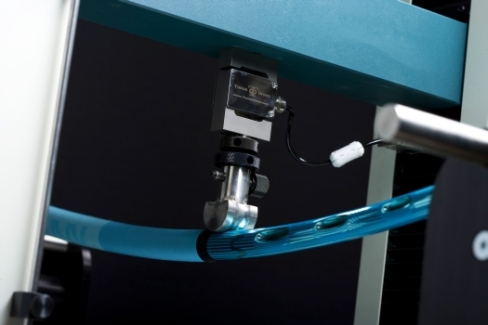
The flex of a stick is the number of millimeters a stick will bend under the pressure of 30kgs. That means the higher the flex, the easier it will bend. Further in this article, we will give you advice on what flex will suit you best as a beginner (spoiler: 29-32mm).
Blade
A blade is another important element of a stick and has two different variables – apart from the wide variety of colors you can purchase them in.
IMPORTANT: You will notice there are left and right sticks as well as blades and you may wonder if you need a left or a right stick. If you order a RIGHT stick/blade, it means your lower hand is your RIGHT hand. If you buy a floorball stick which is LEFT, your LEFT hand will be the lower hand. The biggest tip on how to choose a floorball stick? Buy at least the right side (I did this wrong once, I admit!)

Plastic
A floorball blade is made of plastic but you’d be surprised to find out how many different varieties of plastic are on the floorball market. We don’t want to overwhelm you with all the different kinds of plastic and technical details but instead keep it short and simple. If you are interested in all the nitty-gritty details we recommend you check out this video but for everybody else, this is what you need to know:
Soft (SB): these blades are soft on the touch and you will feel a noticeable difference because the ball doesn’t bounce off the blade easily. However, when shooting hard a soft blade is less accurate, for example with a slapshot.
Medium (MB): these are the all-around blades and constitute the majority of the blades. Most professionals play with an MB because it offers the best playability in combination with a strong blade.
Hard (HB): with a hard blade the ball is controlled less easily but some players prefer this kind of blades because the blade is tougher and can withstand more force. If you are a bodybuilder that just started with floorball, perhaps check this out after you broke your first blade 😉

Shape
The shape of a blade is often neglected by beginners, simply because they don’t have the experience to know which blade works for them or not. This is a huge waste as the choice of a good blade can make the life of a floorball beginner much easier. Conversely, a bad blade can make your learning curve a steep one, if it makes everything you want to do much harder.
Don’t get me wrong, there are no ‘good’ and ‘bad’ blades quality-wise but there are worse and better choices for you personally that suits your level and playing style
Let’s have a look at some different blades to see what I mean:
Some professional players, like the Norwegian veteran Ketel Kronberg (watch this video if you want to see him in action) like their blade as straight as a die. Although he is perhaps an extreme example, this blade suits his physical playing style very well, as he can move as easily on the forehand as on the backhand, making him hard to stop for defensemen.
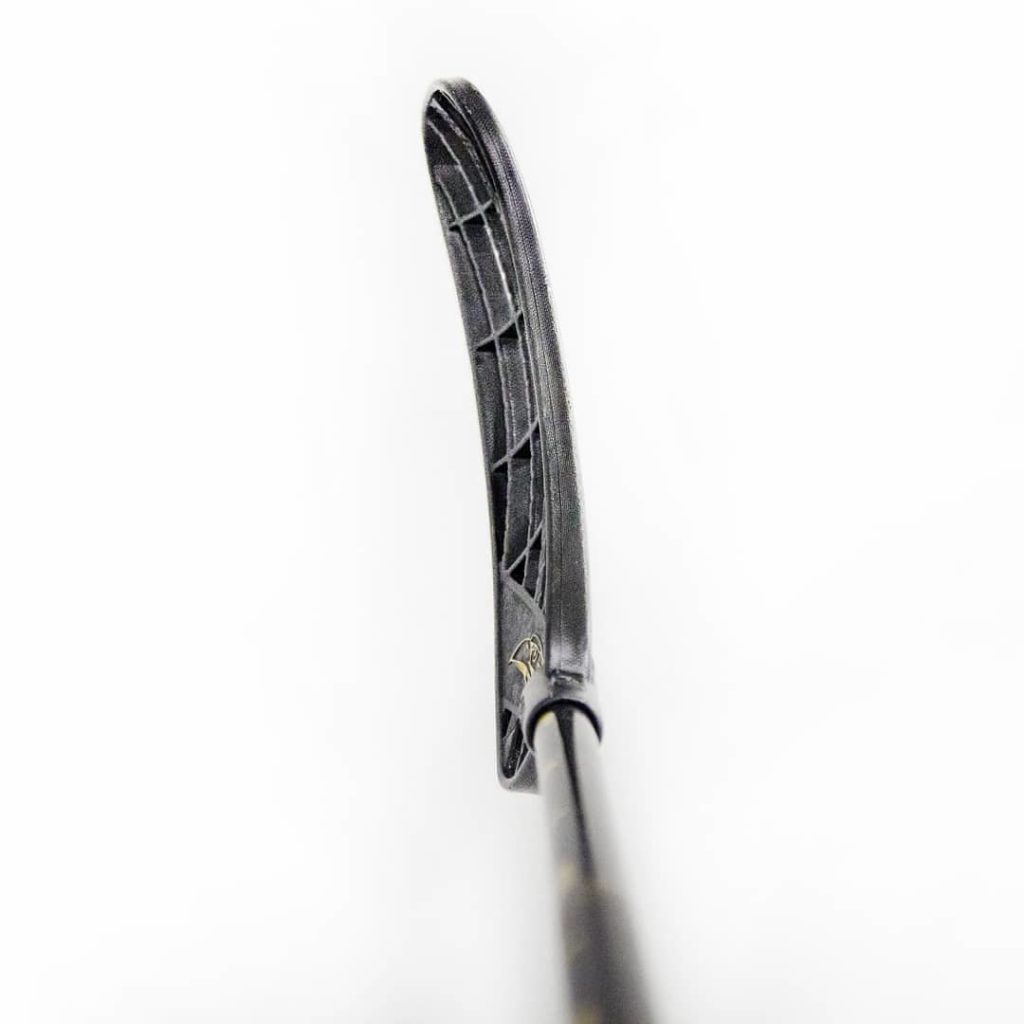
Can you spot the difference? This blade is much more concaved and the backhand and forehand side is much easier to distinguish between. It also opens up possibilities for fierce sweepershots as you can see in this video.
IMPORTANT: Because of safety concerns, the brand of the shaft and the blade has to match. While it’s perfectly fine to change the blade of your stick to a different blade of the same brand, it’s not allowed to change the blade to that of another brand.
Grip
The grip is another element that is somewhat forgotten quite easily. It is perhaps the least important part of a stick but for now, our recommendation of changing your grip once a while will suffice.
Now that we have covered the basics of a floorball stick, it’s time to get some hands-on pointers about how to choose your first floorball stick before moving on to our recommendations.
What You Should Look for as a Beginner
Next in this guide on how to choose a floorball stick, we will discuss some pointers for buying the right stick. As a beginner, you need a different stick than intermediate or advanced players. Let these pointers guide you towards buying your first floorball stick.
Right Length
It’s important to choose the right length when buying a floorball stick. A general rule of thumb is that your floorball stick has to reach your belly button when it’s standing up straight. However, some players like their stick a bit longer than this and others feel better playing when their floorball stick is a bit shorter. This preference will slowly surface over the years. In the meanwhile, you can use this chart to see which floorball stick length would be on average the best fit for you:
A useful chart to pick the correct stick length (credits to efloorball.net)
| Player height | Floorball stick length |
|---|---|
| 110 cm | 50-55 cm |
| 115 cm | 50-55 cm |
| 120 cm | 60-67 cm |
| 125 cm | 60-67 cm |
| 130 cm | 70-77 cm |
| 135 cm | 70-80 cm |
| 140 cm | 80-82 cm |
| 145 cm | 80-82 cm |
| 150 cm | 85-87 cm |
| 155 cm | 85-90 cm |
| 160 cm | 90-92 cm |
| 165 cm | 90-92 cm |
| 170 cm | 91-96 cm |
| 175 cm | 95-96 cm |
| 180 cm | 95-98 cm |
| 185 cm | 95-103 cm |
| 190 cm | 100-103 cm |
| > 195 cm | 103-105 cm |
Generally, a 96cm stick will fit most people well and can be safely purchased if you don’t really exactly know what you’re looking for.
A blade that suits you
I talked about blades before and briefly discussed that they differ mostly in terms of plastic and shape. There are a number of floorball brands selling floorball equipment and all sell different sticks and have different blades.
All of the brands sell different blades for different playing styles ranging from very shoot-heavy blades to more straight and all-round floorball blades.
That’s why I don’t recommend one single brand. You may have heard teammates who swear by one particular floorball brand and of course this is fine. However, it’s good to know that at the start of your floorball journey, it’s not gonna make a difference which brand you choose. In short, all brands will do fine as long as they are IFF Certified. As you continue on your floorball path you may vibe better with one brand and decide to stick to it (no pun intended).
For now, however, it’s far more important to focus on the technical details of the blade, rather than who manufactured it. But don’t worry, we keep it simple.
When it comes to blades we recommend either an all-round blade or a shooting blade. An all-round blade has a medium concavity to help you with your shots but still keeps your passes low while a shooting blade has a larger concavity which will help you a lot with your shots? Because in my experience beginners tend to have a hard time shooting on goal and getting the ball off the floor, a blade that helps you at the start of your floorball career will be a helpful tool.
Passing and shooting are essential components of floorball and getting the hang of those floorball skills should come first. What blades are we talking about?
- Unihoc – Epic (all-round), Unity (shooter)
- Zone – Zuper (all-round), Hyper (shooter)
- Salming – Q1 (all-round), Hawk (shooter)
- Oxdog – Razor (all-round), Avox (shooter)
- Fatpipe – Orc (all-round), Jab (shooter)
If you stick to these blades you can’t go wrong.
IFF Certified Equipment
The International Floorball Federation is the ruling body that governs the national federations and plays an important role in the development of floorball. They also concern themselves with the safety regulations of their players and one way they do this is by only allowing IFF Certified equipment in “official” floorball games.
Of course, this isn’t necessary if you want to play on the street with some friends but your aspirations are of course higher than that. If you want to play in any national tournament or competition it’s mandatory to have an IFF Certified stick.
The good news is that all popular brands have their sticks IFF approved – and of course all of our recommendations too. However, beware that the penalty of playing with illegal equipment is harsh and will lead to a red card during play.

Not sure about if your stick is IFF Certified Equipment? Try to find this logo, it should be somewhere. Most of the time you’ll find it.
Don’t Overdo it for Your First Stick
Just like in any sports there are different classes in the material. Soccer shoes range from €15 all the way to €300+, you can buy hockey skates for €90 but also €900 and tennis rackets range from €25-450. Floorball is no exception to this although the costs of playing our sport nearly don’t come close to the aforementioned sports.
However, there is a danger that you overdo your first stick. Right now, the most expensive stick on the market is the Unihoc Carbskin Curve and this top-of-the-line product sells for around €210. The sticks main strength is its weight which some(!) professional players find very important.

For a beginner, we would recommend a cheaper stick. Here are some reasons why this makes sense.
You save a lot of money
Floorball is a beginner-friendly sport when it comes to products. The lightest stick cost a lot of money but producers make sure to friendly price the heavier sticks because they cost much less in research costs.
Take advantage of this for your first stick.
The sticks are sturdier
In the last couple of years, we saw the stick producers fight a public battle who could make the lightest stick of the market. This is of course a positive thing but especially in the early days, the lightest sticks on the market broke relatively easily. Since then, the stick brands have come a long way in adding strength as an important factor as well.
The rule of thumb still stands: heavier, cheaper sticks break less easily than lighter, more expensive ones.
Floorball is a beautiful elegant sport, but as a beginner to floorball you will see yourself getting slashed a lot (of course, not the other way ;-)). The last thing you want is your new precious stick to break on the first time it sees the light of day to end up like the stick below:
It Won’t Make much of a Difference Anyway
Maybe the most important reason is that it will not matter a lot anyway. Since you have just started playing you will not really benefit from the decreased weight.
Our Top 4 Recommendations
This guide won’t be complete without giving you a couple of our recommendations. We kept ourselves to a couple of rules:
- Price lower than €70
- Beginner-friendly blade
- Available in different lengths and sides
- IFF Certified Equipment
- The right flex
IMPORTANT: For these recommendations, we picked senior sticks. If you are looking for smaller beginner floorball sticks or youth floorball sticks, we can recommend the friendly-priced Zone floorball Hyper Composite 29 White/Turquoise or the Salming Raptor Tourlite Youth.
The Best Floorball Sticks for Beginners
So without further ado, here are our recommendations for the best floorball sticks for beginners.
Fat Pipe BOOST 31 BLUE JAB FH2 – €54,01
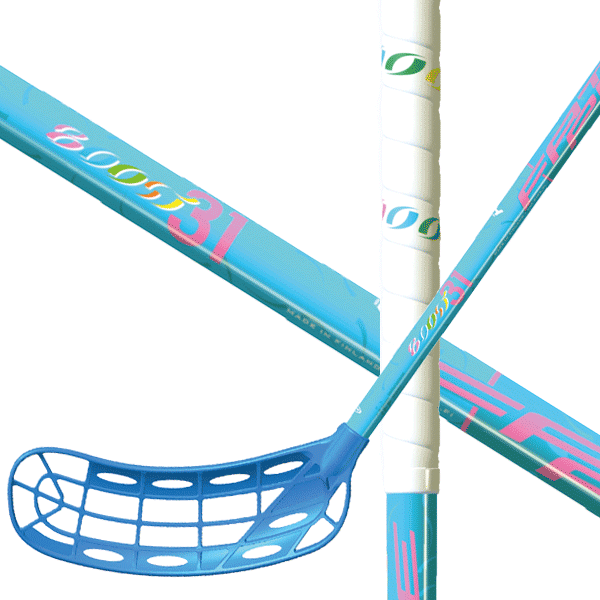
This stick is an excellent entry model that with proper use will last a long time. It is not only very friendly priced but also holds the very popular Fatpipe Jab blade, one of my personal favorites.
You can purchase this stick through this link.
Unihoc Sniper 30 – from around €20,00
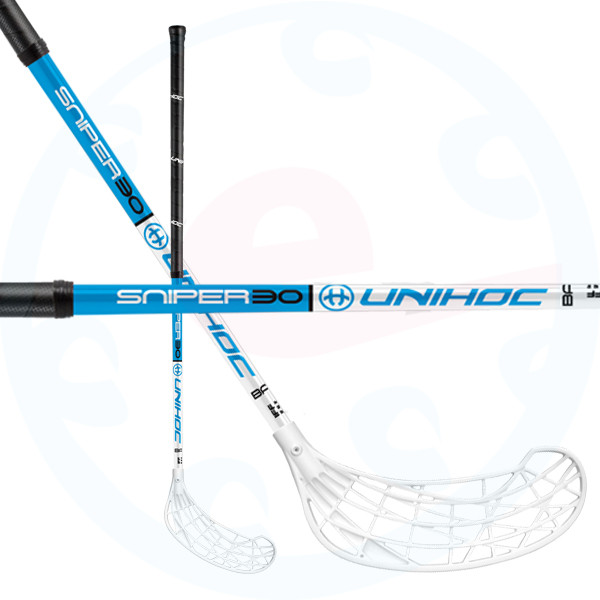
This is the cheapest option that would still get you an IFF Certified stick. This beginner stick is usually purchased by clubs or schools since it’s cheap and tough so chances are big that you already played a lot with this stick and are actually looking to get away from it.
Although at times it will feel like you brought an axe to a fencing duel, you can’t ever go wrong by buying this stick because of the price. The stick is not for everyone as it lacks a good blade which is arguably the most important part of a stick but it will do its job.
You can purchase this stick through this link.
Zone floorball HYPER Composite 27 White/Black – 57,52

Zone’s entry-level stick is perhaps the most stylish stick of this list. This black/white stick is equipped with a shooting blade called Hyper which will help you tremendously with your shots.
You can purchase this stick through this link.
Unihoc EPIC Composite 29 White/Light Green – €68.48
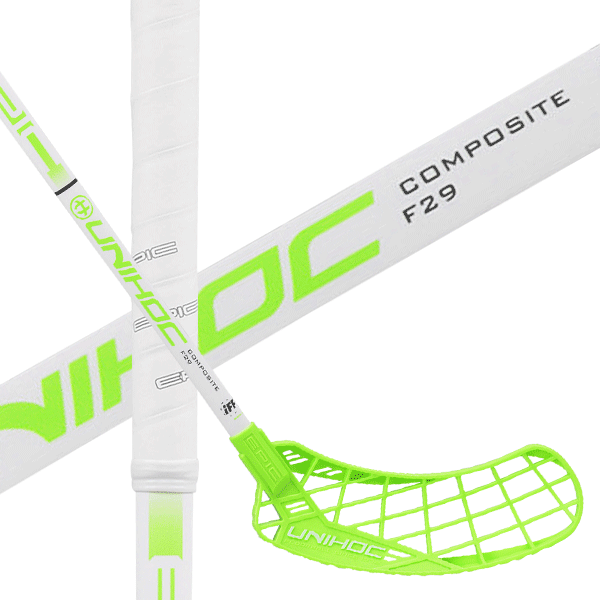
The Epic Composite White/Green is Unihoc’s flagship in the entry-level segment. Powered by the ever-so-popular Epic blade this stick is a good choice for this season. The stick has a nice balance and the Epic blade is very suited for beginners. The reason is the slight concavity of the blade which makes shooting a breeze without interfering with the passing capabilities of the blade.
You can purchase this stick through this link.
Summary
So that was all! We hope you were able to find your next stick after reading this guide or at least know what to look for. Just to summarize the most important factors you should be looking for:
- We don’t recommend buying too expensive sticks
- Beginner-friendly blade (all-round or shooting) in MB or SB
- Make sure you pick the right length and side
- Look if it’s IFF Certified
- The right flex!



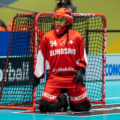
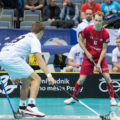
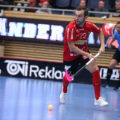

No Comments
Leave a comment Cancel